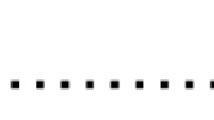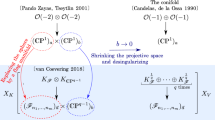Abstract
On any manifold, any nondegenerate symmetric 2-form (metric) and any nondegenerate skew-symmetric differential form ω can be reduced to a canonical form at any point but not in any neighborhood: the corresponding obstructions are the Riemannian tensor and dω. The obstructions to flatness (to reducibility to a canonical form) are well known for any G-structure, not only for Riemannian or almost symplectic structures. For a manifold with a nonholonomic structure (nonintegrable distribution), the general notions of flatness and obstructions to it, although of huge interest (e.g., in supergravity) were not known until recently, although particular cases have been known for more than a century (e.g., any contact structure is nonholonomically “flat”: it can always be reduced locally to a canonical form). We give a general definition of the nonholonomic analogues of the Riemann tensor and its conformally invariant analogue, the Weyl tensor, in terms of Lie algebra cohomology and quote Premet’s theorems describing these cohomologies. Using Premet’s theorems and the SuperLie package, we calculate the tensors for flag manifolds associated with each maximal parabolic subalgebra of each simple Lie algebra (and in several more cases) and also compute the obstructions to flatness of the G(2)-structure and its nonholonomic superanalogue.
Similar content being viewed by others
References
H. Hertz, The Principles of Mechanics Presented in a New Form, Macmillan, London (1899).
H. Poincaré, Rev. Gen. des Sci. Pures et Appl., 8, 734–743 (1897).
A. M. Vershik and V. Ya. Gershkovich, “Nonholonomic dynamical systems, geometry of distributions, and variational problems,” in: Dynamical Systems VII: Integrable Systems: Nonholonomic Dynamical Systems (Encycl. Math. Sci., Vol. 16, V. I. Arnol’d and S. P. Novikov, eds.), Vol. 16, Springer, Berlin (1994), p. 1–85.
A. M. Vershik, “Classical and nonclassical dynamics with constraints,” in: Global Analysis: Studies and Applications I (Lect. Notes Math., Vol. 1108, Yu. G. Borisovich and Yu. E. Gliklikh, eds.), Springer, Berlin (1984), pp. 278–301.
A. Agrachev and Yu. Sachkov, Control Theory from the Geometric Viewpoint (Encycl. Math. Sci., Vol. 87), Springer, Berlin (2004).
A. M. Bloch, Nonholonomic Mechanics and Control (Interdiscip. Appl. Math., Vol. 24), Springer, New York (2003).
V. M. Sergeev, The Limits of Rationality: A Thermodynamic Approach to Market Equilibrium [in Russian], Fazis, Moscow (1999).
V. V. Kozlov, Thermal Equilibrium per Gibbs and Poincaré, Institute for Computer Research, Moscow (2002).
V. Sergeev, “The thermodynamical approach to market,” MPIMiS Preprint 76/2006 (translated from the Russian and edited by D. Leites), http://www.mis.mpg.de/preprints/2006/prepr2006_76.html (2006).
D. Leites, Homology Homotopy Appl., 4, 397–407 (2002); arXiv:math/0202213v1 [math.RT] (2002); Proc. Workshop on Mathematical Physics and Geometry (ICTP, Trieste, Italy, March 4–15, 1991) (1991), http://agenda.ictp.trieste.it/agenda/current/fullAgenda.php?ida=a02210.
D. Leites and E. Poletaeva, “Supergravities and contact type structures on supermanifolds,” in: 2nd Intl. Conf. on Algebra (Contemp. Math., Vol. 184), Amer. Math. Soc., Providence, R. I. (1995), p. 267–274.
P. Grozman and D. Leites, “From supergravity to ballbearings,” in: Supersymmetries and Quantum Symmetries (Lect. Notes Phys., Vol. 524, J. Wess and E. A. Ivanov, eds.), Springer, Berlin (1999), p. 58–67.
N. Tanaka, J. Math. Soc. Japan, 22, 180–212 (1970).
N. Tanaka, J. Math. Kyoto Univ., 10, 1–82 (1970).
N. Tanaka, Hokkaido Math. J., 8, No. 1, 23–84 (1979).
K. Yamaguchi, “Differential systems associated with simple graded Lie algebras,” in: Progress in Differential Geometry (Adv. Stud. Pure Math., Vol. 22), Math. Soc. Japan, Tokyo (1993), p. 413–494.
K. Yamaguchi and T. Yatsui, “Geometry of higher order differential equations of finite type associated with symmetric spaces,” in: Lie Groups, Geometric Structures, and Differential Equations: One Hundred Years After Sophus Lie (Adv. Stud. Pure Math., Vol. 37, T. Morimoto, H. Sato, and K. Yamaguchi, eds.), Math. Soc. Japan, Tokyo (2002), p. 397–458.
V. Dragovic and B. Gajic, Regul. Chaotic Dyn., 8, 105–123 (2003); arXiv:math-ph/0304018v1 (2003).
P. Grozman, “SuperLie,” http://www.equaonline.com/math/SuperLie (2007).
R. J. Baston, Duke Math. J., 63, 81–112, 113–138 (1991).
A. Čap and H. Schichl, Hokkaido Math. J., 29, 453–505 (2000).
A. Čap, J. Reine Angew. Math., 582, 143–172 (2005); arXiv:math/0102097v3 [math.DG] (2001).
A. Čap and J. Slovák, Math. Scand., 93, No. 1, 53–90 (2003); arXiv:math/0001166v1 [math.DG] (2000).
A. Čap, J. Slovák, and V. Souček, Ann. of Math. (2), 154, 97–113 (2001).
A. Čap and J. Slovák, Rend. Circ. Mat. Palermo (2) Suppl., No. 43, 95–101 (1996).
A. S. Galperin, E. A. Ivanov, V. I. Ogievetsky, and E. S. Sokatchev, Harmonic Superspace (Cambridge Monogr. Math. Phys.), Cambridge Univ. Press, Cambridge (2001).
P. Heslop and P. S. Howe, Class. Q. Grav., 17, 3743–3768 (2000).
K. Ehlers, J. Koiller, R. Montgomery, and P. Rios, “Nonholonomic systems via moving frames: Cartan equivalence and Chaplygin Hamiltonization,” in: The Breadth of Symplectic and Poisson Geometry (Progr. Math., Vol. 232, J. E. Marsden and T. S. Ratiu, eds.), Birkhauser, Boston, Mass. (2005), p. 75–120.
J. N. Tavares, J. Geom. Phys., 45, 1–23 (2003).
I. M. Shchepochkina, Theor. Math. Phys., 147, 821–838 (2006); arXiv:math/0509472v1 [math.RT] (2005).
S. Vacaru, Interactions, Strings, and Isotopies in Higher Order Anisotropic Superspaces, Hadronic Press, Palm Harbor, Fla. (1998).
A. B. Goncharov, Funct. Anal. Appl., 15, 221–223 (1981); Selecta Math. Soviet., 6, 307–340 (1987).
B. Kostant, “A generalization of the Bott-Borel-Weil theorem and Euler number multiplets of representations,” in: Conférence Moshé Flato, 1999 (Math. Phys. Stud., Vol. 21), Vol. 1, Quantization, Deformations, and Symmetries, Kluwer, Dordrecht (2000), p. 309–325; Lett. Math. Phys., 52, 61–78 (2000).
S. Sternberg, Lectures on Differential Geometry (2nd ed.), Chelsey, New York (1983).
V. Guillemin, Trans. Amer. Math. Soc., 116, 544–560 (1965).
J. Wess and J. Bagger, Supersymmetry and Supergravity, Princeton Univ. Press, Princeton, N. J. (1992).
Yu. Manin, Gauge Field Theory and Complex Geometry (Grundlehren Math. Wiss., Vol. 289), Springer, Berlin (1997).
D. Leites and I. Shchepochkina, “Classification of the simple Lie superalgebras of vector fields,” Preprint MPIM-2003-28 (2003).
I. Shchepochkina, C. R. Acad. Bulgare Sci., 36, 313–314 (1983).
I. M. Shchepochkina, Funct. Anal. Appl., 33, 208–219 (1999).
I. Shchepochkina, Represent. Theory, 3, 373–415 (1999).
P. Woit, “Quantum field theory and representation theory: A sketch,” arXiv:hep-th/0206135v1 (2002).
D. Leites, E. Poletaeva, and V. Serganova, J. Nonlinear Math. Phys., 9, 394–425 (2002); arXiv:math/0306209v1 [math.DG] (2003).
M. Atiyah and E. Witten, Adv. Theor. Math. Phys., 6, 1–106 (2002).
R. L. Bryant, “Some remarks on G 2-structures,” arXiv:math/0305124v4 [math.DG] (2005).
V. V. Fock and A. B. Goncharov, “Cluster X-varieties, amalgamation, and Poisson-Lie groups,” in: Algebraic Geometry and Number Theory (Progr. Math., Vol. 253), Birkhäuser, Boston, Mass. (2006), pp. 27–68; arXiv:math/0508408v2 [math.RT] (2005).
P. Grozman and D. Leites, “SuperLie and problems (to be) solved with it,” Preprint MPIM-Bonn 2003-39 (2003).
E. Poletaeva, “Analogs of the Riemannian and Penrose tensors on supermanifolds,” arXiv:math/0510165v1 [math.RT] (2005).
D. Leites, V. Serganova, and G. Vinel, “Classical superspaces and related structures,” in: Differential Geometric Methods in Theoretical Physics (Lect. Notes Phys., Vol. 375, U. Bruzzo et al., eds.), Springer, Berlin (1991), pp. 286–297.
I. Penkov and V. Serganova, Ann. Inst. Fourier (Grenoble), 39, 845–873 (1989).
Y. Se-Ashi, Hokkaido Math. J., 17, 151–195 (1988).
T. Morimoto, Hokkaido Math. J., 22, 263–347 (1993); “Lie algebras, geometric structures, and differential equations on filtered manifolds,” in: Lie Groups, Geometric Structures, and Differential Equations: One Hundred Years After Sophus Lie (Adv. Stud. Pure Math., Vol. 37, T. Morimoto, H. Sato, and K. Yamaguchi, eds.), Math. Soc. Japan, Tokyo (2002), p. 205–252.
B. Feigin and D. Fuchs, “Cohomologies of Lie groups and Lie algebras,” in: Lie Groups and Lie Algebras: II (Encycl. Math. Sci., Vol. 21), Springer, Berlin (2000), p. 125–223.
Sh. Kobayashi and K. Nomizu, Foundations of Differential Geometry, Vols. 1, 2, Wiley, New York (1963, 1969).
V. Gershkovich and A. Vershik, J. Geom. Phys., 5, 407–452 (1988); A. M. Vershik and V. Ya. Gershkovich, J. Soviet Math., 59, 1040–1053 (1992).
R. Montgomery, “Engel deformations and contact structures,” in: Northern California Symplectic Geometry Seminar (Amer. Math. Soc. Transl. Ser. 2, Vol. 196), Amer. Math. Soc., Providence, R. I. (1999), pp. 103–117.
V. Ovsienko and S. Tabachnikov, Projective Differential Geometry Old and New: From Schwarzian Derivative to Cohomology of Diffeomorphism Groups (Cambridge Tracts Math., Vol. 165), Cambridge Univ. Press, Cambridge (2005).
I. Biswas and A. Raina, Internat. Math. Res. Notices, No. 15, 753–768 (1996); No. 13, 685–716 (1999); Differential Geom. Appl., 15, 203–219 (2001).
P. Grozman, D. Leites, and I. Shchepochkina, “Analogues of the Riemann tensor for exceptional structures on supermanifolds [in Russian],” in: Fundamental Mathematics Today: In Honor of the 10th Anniversary of the Independent University of Moscow (S. K. Lando and O. K. Sheinman, eds.), MCCME, Moscow (2003), p. 89–109; arXiv:math/0509525v1 [math.RT] (2005).
M. Zhitomirskii, Typical Singularities of Differential 1-forms and Pfaffian Equations (Transl. Math. Monogr., Vol. 113), Amer. Math. Soc., Providence, R. I. (1992).
A. Lebedev, D. Leites, and I. Shereshevskii, “Lie superalgebra structures in \(C^ \bullet (\mathfrak{n};\mathfrak{n})\) and \(H^ \bullet (\mathfrak{n},\mathfrak{n})\),” in: Lie Groups and Invariant Theory (Amer. Math. Soc. Transl. Ser. 2, Vol. 213, É. Vinberg, ed.), Amer. Math. Soc., Providence, R. I. (2005), p. 157–172; arXiv:math/0404139v1 [math.KT] (2004).
I. N. Bernstein, I. M. Gelfand, and S. I. Gelfand, “Differential operators on the base affine space and a study of \(\mathfrak{g}\)-modules,” in: Lie Groups and Their Representations (Proc. Summer School, Bolyai János Math. Soc., Budapest, 1971), Halsted, New York (1975), p. 21–64.
N. Bourbaki, Lie Groups and Lie Algebras (Chap. 4–6), Springer, Berlin (2002).
È. B. Vinberg and A. L. Onishchik, Seminar on Lie Groups and Algebraic Groups [in Russian], Nauka, Moscow (1988); English transl.: A. L. Onishchik and E. B. Vinberg Lie Groups and Algebraic Groups, Springer, Berlin (1990).
P. Grozman and D. Leites, Czechoslovak J. Phys., 51, 1–21 (2001); arXiv:hep-th/9702073v1 (1997).
I. B. Penkov, J. Soviet Math., 51, 2108–2140 (1990).
Author information
Authors and Affiliations
Corresponding author
Additional information
__________
Translated from Teoreticheskaya i Matematicheskaya Fizika, Vol. 153, No. 2, pp. 186–219, November, 2007.
Rights and permissions
About this article
Cite this article
Grozman, P.Y., Leites, D.A. Nonholonomic Riemann and Weyl tensors for flag manifolds. Theor Math Phys 153, 1511–1538 (2007). https://doi.org/10.1007/s11232-007-0131-z
Received:
Revised:
Issue Date:
DOI: https://doi.org/10.1007/s11232-007-0131-z




